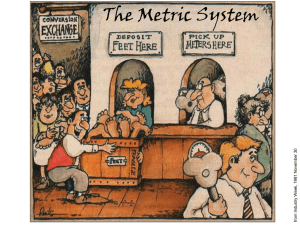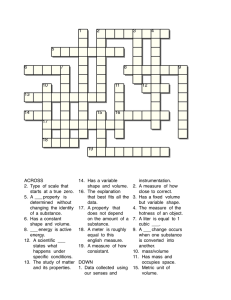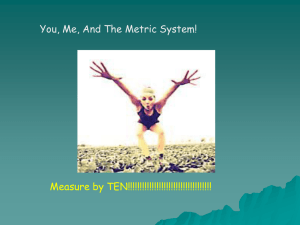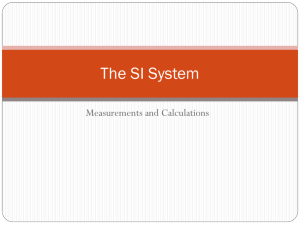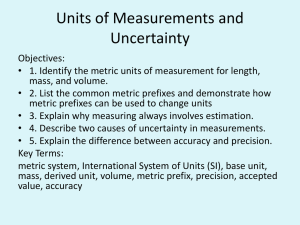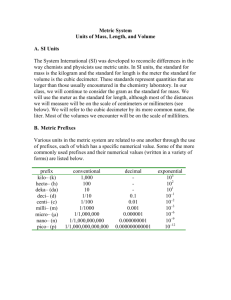History & SI Units: Scientific Measurement Textbook Excerpt
advertisement
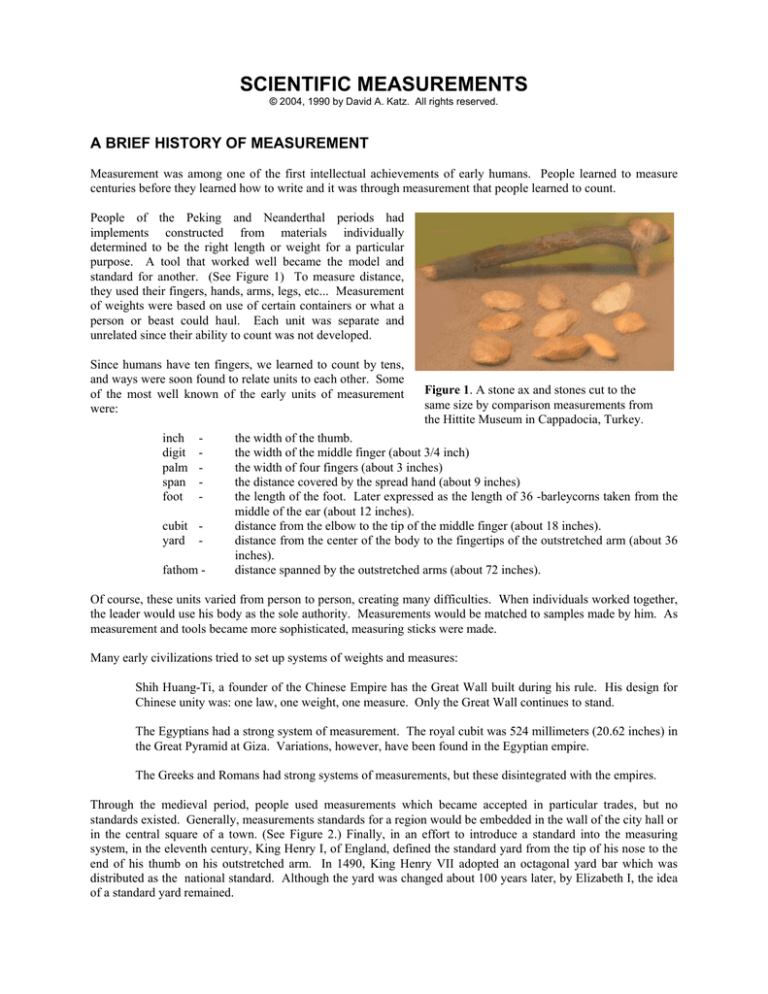
SCIENTIFIC MEASUREMENTS
© 2004, 1990 by David A. Katz. All rights reserved.
A BRIEF HISTORY OF MEASUREMENT
Measurement was among one of the first intellectual achievements of early humans. People learned to measure
centuries before they learned how to write and it was through measurement that people learned to count.
People of the Peking and Neanderthal periods had
implements constructed from materials individually
determined to be the right length or weight for a particular
purpose. A tool that worked well became the model and
standard for another. (See Figure 1) To measure distance,
they used their fingers, hands, arms, legs, etc... Measurement
of weights were based on use of certain containers or what a
person or beast could haul. Each unit was separate and
unrelated since their ability to count was not developed.
Since humans have ten fingers, we learned to count by tens,
and ways were soon found to relate units to each other. Some
of the most well known of the early units of measurement
were:
inch
digit
palm
span
foot
-
cubit yard fathom -
Figure 1. A stone ax and stones cut to the
same size by comparison measurements from
the Hittite Museum in Cappadocia, Turkey.
the width of the thumb.
the width of the middle finger (about 3/4 inch)
the width of four fingers (about 3 inches)
the distance covered by the spread hand (about 9 inches)
the length of the foot. Later expressed as the length of 36 -barleycorns taken from the
middle of the ear (about 12 inches).
distance from the elbow to the tip of the middle finger (about 18 inches).
distance from the center of the body to the fingertips of the outstretched arm (about 36
inches).
distance spanned by the outstretched arms (about 72 inches).
Of course, these units varied from person to person, creating many difficulties. When individuals worked together,
the leader would use his body as the sole authority. Measurements would be matched to samples made by him. As
measurement and tools became more sophisticated, measuring sticks were made.
Many early civilizations tried to set up systems of weights and measures:
Shih Huang-Ti, a founder of the Chinese Empire has the Great Wall built during his rule. His design for
Chinese unity was: one law, one weight, one measure. Only the Great Wall continues to stand.
The Egyptians had a strong system of measurement. The royal cubit was 524 millimeters (20.62 inches) in
the Great Pyramid at Giza. Variations, however, have been found in the Egyptian empire.
The Greeks and Romans had strong systems of measurements, but these disintegrated with the empires.
Through the medieval period, people used measurements which became accepted in particular trades, but no
standards existed. Generally, measurements standards for a region would be embedded in the wall of the city hall or
in the central square of a town. (See Figure 2.) Finally, in an effort to introduce a standard into the measuring
system, in the eleventh century, King Henry I, of England, defined the standard yard from the tip of his nose to the
end of his thumb on his outstretched arm. In 1490, King Henry VII adopted an octagonal yard bar which was
distributed as the national standard. Although the yard was changed about 100 years later, by Elizabeth I, the idea
of a standard yard remained.
Figure 2. Above: Measurement standards embedded in the
wall of the city hall in Assisi, Italy. The measurements are
the foot, the cubit, and the yard. Right: Measurements in the
wall of the city hall in Regensburg, Germany.
The
measurements are the foot, the yard, and the fathom.
A parliamentary Committee undertook the job of clearing away the medieval weights and measures, setting up a
standard system of weights and measures in 1824. The Americans, already accustomed to the English system of
weights and measures, set up their system which became standardized in the mid-1900’s.
While the British and Americans were trying to standardize their weights and measures, the National Assembly of
France called upon the French Academy of Science, on May 8, 1790, to “deduce an invariable standard for all of the
measures and all weights”.
In 1791, the French National Assembly approved the report of the French Academy of Sciences outlining the metric
system. On June 19, 1791, a committee of 12 mathematicians, geodesists, and physicists met with Louis XVI and
received his formal approval, one day before he tried to escape from France and was arrested.
The metric system was adopted by France in 1795, but it existed along with use of the old medieval units until 1840
when it proclaimed as the exclusive system of weights and measures.
In 1875, the metric system was universally accepted at the International Metric Convention in France and provisions
were made to set up an International Bureau of Weights and Measures in Paris.
At the 11th General Conference on Weights and Measures, in Paris in October 1960, the definitions of the original
metric standards were redefined to 20th-century standards of measurement and a new International System of Units
was formulated.
THE INTERNATIONAL SYSTEM OF UNITS (SI)
The International System of Units, as amended in 1971, consists of seven base units as listed in Table 1.
Table 1. SI Base Units
Quantity Measured
Length
Mass
Time
Thermodynamic
temperature
Amount of substance
Electric current
Luminous intensity
Unit
meter
kilogram
second
kelvin
Symbol
m
kg
s
K
mole
ampere
candela
mol
A
Cd
The five base units that are useful in general chemistry are defined below:
1. The meter (m) was originally measured to be one ten-millionth of the distance from the north pole to
the equator along the meridian running near Dunkirk, Paris, and Barcelona. It was redefined in 1971
as the length of path traveled by light in a vacuum during the time interval of 1/299 792 458 second.
2. The kilogram (kg) is the mass of a particular cylinder of platinum-iridium alloy, called the
International Prototype Kilogram, kept at the International Bureau of Weights and Measures in
Serves, France. The kilogram, the only unit still defined by an artifact, was derived from the mass of
a cubic decimeter of water.
3. The second (s) was originally defined as 1/86,400th of a mean solar day. It was redefined in 1967 as
the duration of 9,192,631,770 periods of the radiation corresponding to the transition between two
hyperfine levels of the fundamental state of a cesium-133 atom.
4. The kelvin (K) is 1/273.16 of the temperature interval between absolute zero and the triple point of
water (the temperature at which ice, liquid water, and water vapor are in equilibrium). The -Celsius
scale is derived from the -Kelvin scale. An interval of 1 K is equal to 1°C.
5. The mole (mol) is the amount of substance which contains as many entities as there are atoms in
exactly 0.012 kg of carbon-12. This number is known as Avogadro’s Number which has a value of
6.0220943 x 1023 per mole *6.3 x 1017 (determined by U.S. National Bureau of Standards in 1974).
Instead of having a large number of units of different sizes, such as inches, feet, years, fathoms, furlongs, and miles
in the English system, it was decided to use prefixes which would multiply base units by multiples of tens for larger
measurements and decimal fractions for smaller measurements. The prefixes used for multiples and submultiples
of SI units are listed in Table 2. The prefixes commonly used in chemistry are printed in bold print.
Table 2. The SI prefixes
These prefixes multiply base units for
larger measurements
Prefix
exa
peta
tera
giga
mega
kilo
hecto
deka
Symbol
E
P
T
G
M
k
h
da
Multiple
1018
1015
1012
109
106
103
102
10
These prefixes are decimal
fractions that multiply base units
for smaller measurements
Prefix
Symbol Submultiple
d
10-1
deci
c
10-2
centi
m
10-3
milli
10-6
micro
µ
n
10-9
nano
p
10-12
pico
femto
f
10-15
atto
a
10-18
Prefix symbols are printed in Roman type with no space between the prefix symbol and the base unit symbol.
Examples:
millimeter is mm
microsecond is µs
It should be noted that the first letter of the SI abbreviation represents the prefix and the second letter represents the
base unit.
Among the base units, the kilogram has a prefix built into its name. The names of the decimal fractions and
multiples of the kilogram are constructed using the appropriate prefix with the stem word “gram” (symbol: g).
Examples:
megagram is Mg
centigram is cg
When a prefix is affixed to an SI unit, it multiplies the base unit by the appropriate factor listed in Table 2.
Examples:
millimeter:
microsecond:
megagram:
centigram:
kilometer:
1 mm = 10-3 m
1 µs = 10-6 s
1 Mg = 106 g
1 cg = 10-2 g
1 km = 103 m
Since the SI system is based on factors of ten, there are relationships between the metric prefixes that should be
noted. Each of the first three prefixes above or below the base unit either multiply or divide the base unit by ten.
After that, each prefix represents a multiplication or division by 1,000. The factors that relate the more commonly
used SI prefixes are shown in Table 3.
Examples: Using m as the base unit:
1,000 pm
1,000 nm
1,000 µm
10 mm
10 cm
=
=
=
=
=
1 nm
1 µm
1 mm
1 cm
1 dm
To convert between units with difference prefixes, multiply by the factors that occur between them.
examples, using m as the base unit, are shown below.
Some
To convert from nm to mm, we first note that there are 1,000 nm in 1 µm and 1,000 µm in 1 mm, then, to
convert, multiply the two factors of 1,000 together to get:
1,000,000 nm = 1 mm
To convert from µm to cm, multiply the factors of 1,000 µm in 1 mm and 10 mm in 1 cm together to get:
10,000 µm = 1 cm
To convert from cm to km, multiply the factors of 100 cm in 1 m and 1000 m in 1 km to get:
100,000 cm = 1 km
Table 3. Relationship between SI prefixes
Base unit
to mega:
1 000 000
units
micro to
base unit:
1 000 000
units
1000
Base
unit to
kilo:
1000
units
milli
to base
unit:
1000
units
10
10
10
10
10
10
1000
1000
1000
{
{
{
{
{
{
{
{
{
{
Prefix
Symbol
Multiple
mega
M
106
kilo
k
103
hecto
h
102
deka
da
10
deci
d
10-1
centi
c
10-2
milli
m
10-3
micro
µ
10-6
nano
n
10-9
pico
p
10-12
[base unit]
Table 4 lists SI-derived units with special names. The most commonly used units in general chemistry are listed in
bold print. A number of these units are named in honor of individuals who did significant work in the area where
the unit is often used.
Table 4. SI-Derived units with special names
_________________________________________________________
Physical Quantity
Unit
Symbol
Formula
_________________________________________________________
Frequency
hertz
Hz
(cycles) s-1
Force
newton
N
kg · m s-2
Pressure
pascal
Pa
N · m-2
Energy
joule
J
N·m
Power
watt
W
J · s-1
Electric potential
difference
volt
V
W · A-1
Electric charge
coulomb
C
A·s
Electric resistance
ohm
Ω
V · A-1
Electric capacitance
farad
F
C · V-1
Electric conductance siemens
S
A · V-1
Magnetic flux
weber
Wb
V·s
Magnetic flux density tesla
T
Wb · m-2
Inductance
henry
H
Wb · A-1
Luminous flux
lumen
lm
cd · sr(a)
Illuminance
lux
lx
lm · m-2
Activity
(radionuclide)
becquerel
Bq
(disintegration) s-1
Absorbed dose
(radiation)
gray
Gy
m2 · s-2
_________________________________________________________
(a)
sr = steradian
Table 5 lists units that are derived from either SI base units or from the SI derived units with special names. The
units from which each is derived are shown in the column labeled “Symbol”
Table 5. Other SI-Derived Units
_________________________________________________________
Physical Quantity
Unit
Symbol
_________________________________________________________
Area
square meter
m2
Volume
cubic meter
m3
Velocity
meter per second
m · s-1
Acceleration
meter per second squared
m · s-2
Wave number
1 (Wave) per meter
m-1
Density
kilogram per cubic meter
kg · m-3
Concentration
mole per cubic meter
mol · m-3
Molar mass
kilogram per mole
kg · mol-1
Molar volume
cubic meter per mole
m3 · mol-1
Heat capacity
joule per kelvin
J · K-1
Molar energy
joule per mole
J · mol-1
Electric field
strength
volt per meter
V · m-1
Electric dipole
moment
coulomb meter
C·m
_________________________________________________________
In general chemistry, there are certain non-SI units which may be retained due to widespread use. The definitions
of some of these units are given below:
The calorie (cal) is the amount of heat needed to raise the temperature of 1.0 gram of water by 1°C at
15°C.
The erg is the energy involved when a force of one dyne acts through a distance of one centimeter.
A dyne (dyn), is the force required to produce an acceleration of one centimeter per second squared on a
mass of one gram.
The Angstrom (Å) is a unit of length that was commonly used in describing sizes of atoms. One
Angstrom is equal to one-tenth of a nanometer.
The tonne or metric ton (t) is equal to 1000 kg. It is an established commercial unit of volume.
The atmosphere (atm) is the unit of pressure based on the Earth’s standard air pressure at sea level. One
atmosphere pressure is equal to a barometric pressure of 760 mm Hg.
The liter (L) is an established unit of volume in nations using the metric system. It is equal to one cubic
decimeter. (Formerly defined as one kilogram of water.)
Two units of energy that are used with SI whose values are obtained by experiment are:
The electronvolt (eV) is the kinetic energy acquired by an electron passing through a potential difference
of 1 volt in vacuum.
The unified atomic mass unit (u) is equal to the fraction 1/12 of the mass of an atom of the nuclide 12C
Table 6 lists these non-SI units with conversion factors to SI.
Table 6. Non-SI units used in chemistry with conversion factors to SI
_________________________________________________________________________________________
Physical Quantity
SI Unit
Non-SI Unit
Symbol
Conversion Factor
_________________________________________________________________________________________
Energy
joule
calorie
cal
1 cal = 4.184 J
erg
erg
1 erg = 10-7 J
electronvolt
eV
1 eV = 1.60219 x 10-19 J
Force
newton
dyne
dyn
1 dyn = 10-5 N
Length
meter
Angstrom
Å
1 Å = 10-10 m
= 10-1 nm
Mass
kilogram
tonne
t
1 t = 103 kg
atomic mass unit amu
1 amu = 1.66057 x 10-27 kg
Pressure
pascal
atmosphere
atm
1 atm = 1.013 x 105 Pa
torr or mm Hg
1 torr = 1 mm Hg = 133 Pa
Temperature
kelvin
Celsius
°C
1°C = 1 K
Volume
cubic meter
liter
L
1 L = 1 dm3 = 10-3 m3
Time
second
minute
min
1 min = 60 s
hour
hr
1 hr = 3600 s
day
d
1 d = 86 400 s
_________________________________________________________________________________________
Two conversion factors which will be extremely useful, especially in laboratory work are:
The relationship between volume in cubic centimeters and the non-SI unit of liters:
1 cm3 = 1 mL
Note: A cubic centimeter is sometimes called a cc in the medical field
The relationship between volume and mass of water is:
1 mL H2O = 1 g H2O
SOME ENGLISH-SI CONVERSION FACTORS
Although modern chemistry uses only SI units, it may be useful to know some English-SI conversion factors in the
event it may be necessary to convert between the English system and the SI system. There are a great number of
conversion factors that apply to the large number of English units. The ones that will be most useful in everyday
encounters are:
Length:
1 in = 2.54 cm
Volume:
1.057 qt = 1 L
Mass:
1 lb = 453.6 g
Since length has many English units with different names, some other useful conversion factors for length are:
39.37 in = 1 m
1 mi = 1.609 km
Another useful conversion factor for mass is:
2.2 lb = 1 kg
